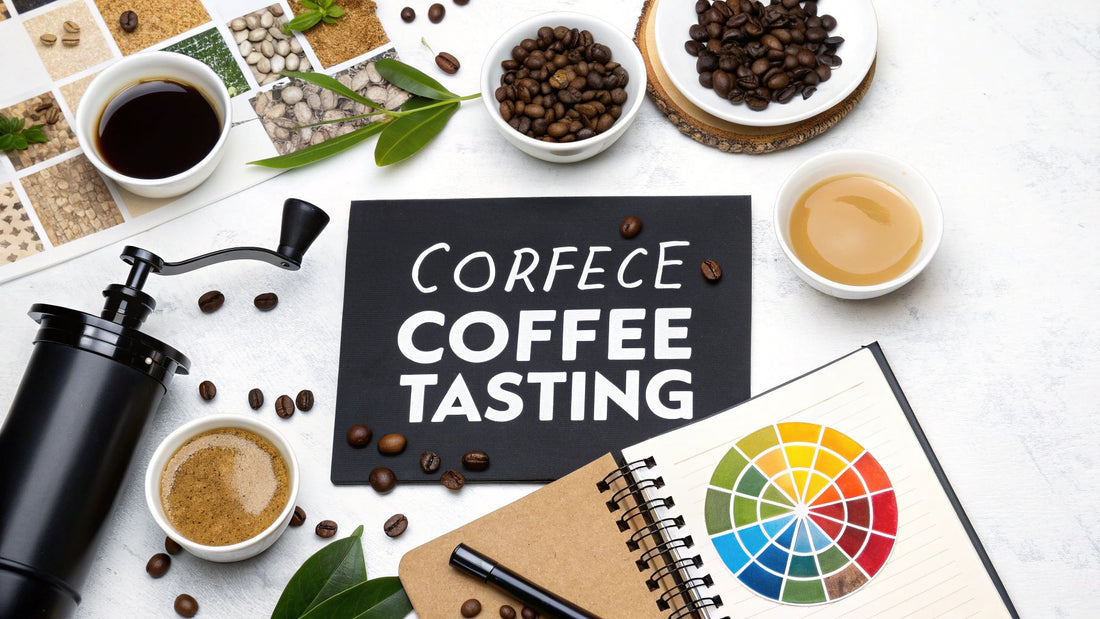
Craft the Perfect Coffee Tasting Experience
Share
A proper coffee tasting is so much more than just drinking a brew. It’s an intentional practice—a multi-sensory journey designed to explore the complex aromas and flavours hiding inside every bean. This is your roadmap to creating a memorable tasting session, right here in the UK.
Discover a Deeper Love for Coffee
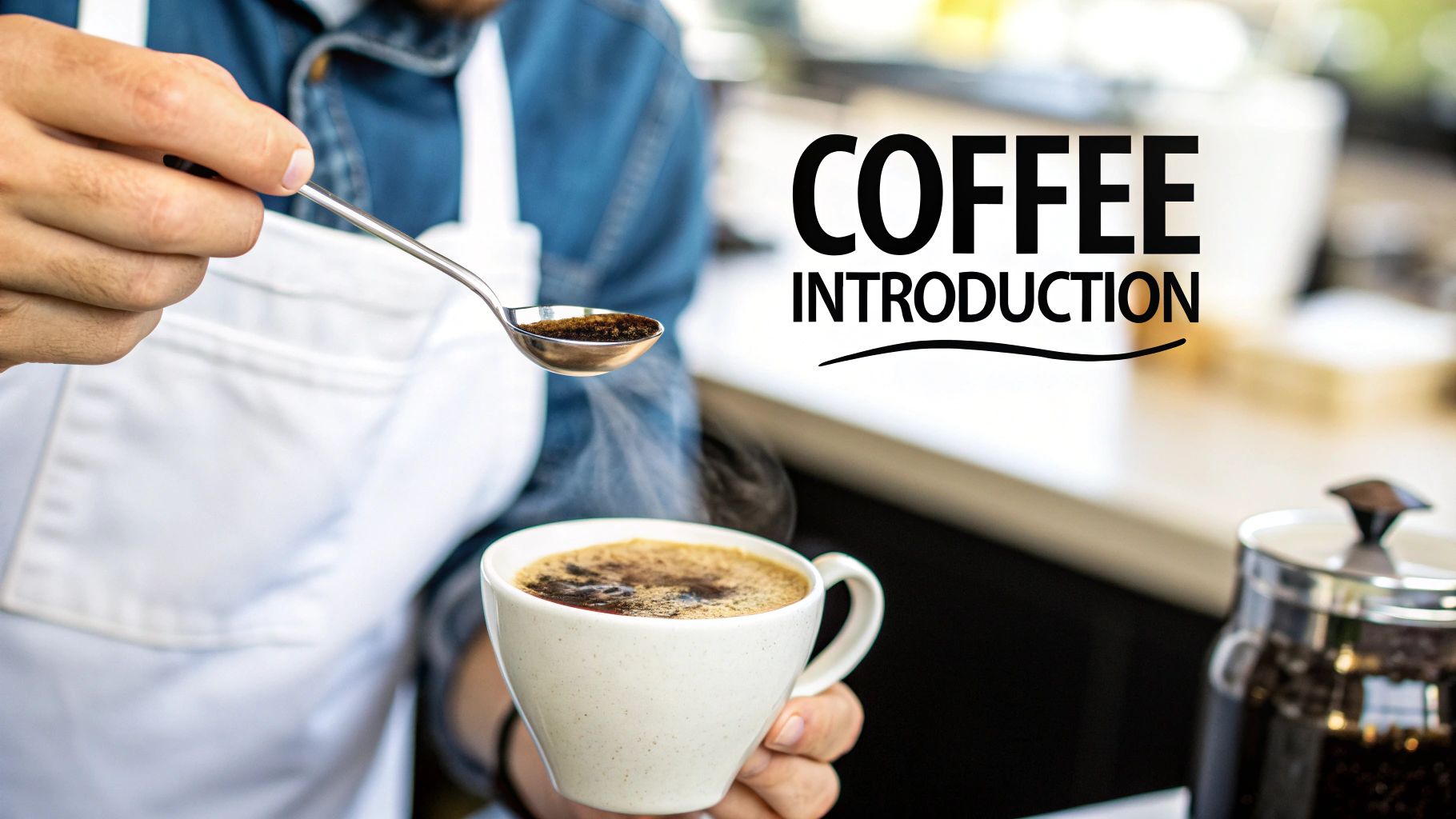
Welcome to the world of coffee tasting, where your daily ritual transforms into an immersive discovery. Forget the caffeine hit for a moment; this is your chance to connect with the incredible craftsmanship behind every cup, from the distant farm to the UK roaster who perfected the beans.
The UK’s coffee culture is absolutely buzzing. There’s a newfound appreciation for quality and origin that's inspiring enthusiasts everywhere—from city flats to quiet country kitchens—to host their own tasting sessions. It’s a brilliant way to gather friends, share a unique experience, and learn something new together.
The Rise of the UK Coffee Scene
This growing curiosity is directly linked to the incredible boom in the UK's coffee shop market. A recent report showed that the UK's branded coffee shop market grew by 7.3% in just one year to over 11,400 outlets nationwide.
This surge isn’t just about grabbing a flat white on the go. It highlights a real public appetite for diverse, speciality brews—an appetite a great tasting session can truly satisfy. You can dig into more insights on the UK coffee market growth to see how this trend is shaping our culture.
A well-organised coffee tasting is a story you tell through flavour. Each coffee represents a different chapter—a different origin, processing method, or roast profile that invites curiosity and conversation.
What This Guide Will Offer You
Think of this guide as your complete companion, whether you're planning an intimate tasting at home or a more formal event at a local cafe. We’ll cover everything you need to feel confident and prepared.
Here’s a taste of what’s to come:
- Sourcing Incredible Beans: We’ll show you how to select a compelling flight of coffees from some of the UK’s most brilliant independent roasters.
- Creating the Perfect Ambience: Learn how to set up a tasting space that focuses the senses and feels both professional and inviting.
- Mastering Sensory Skills: We'll walk you through the essential steps of smelling, tasting, and describing coffee like an expert.
- Elevating the Experience: Get creative ideas for food pairings and themes that will make your tasting truly unforgettable.
Get ready. You’re about to embark on a journey that will forever change how you see, smell, and taste your morning brew.
Source Incredible Beans from UK Roasters
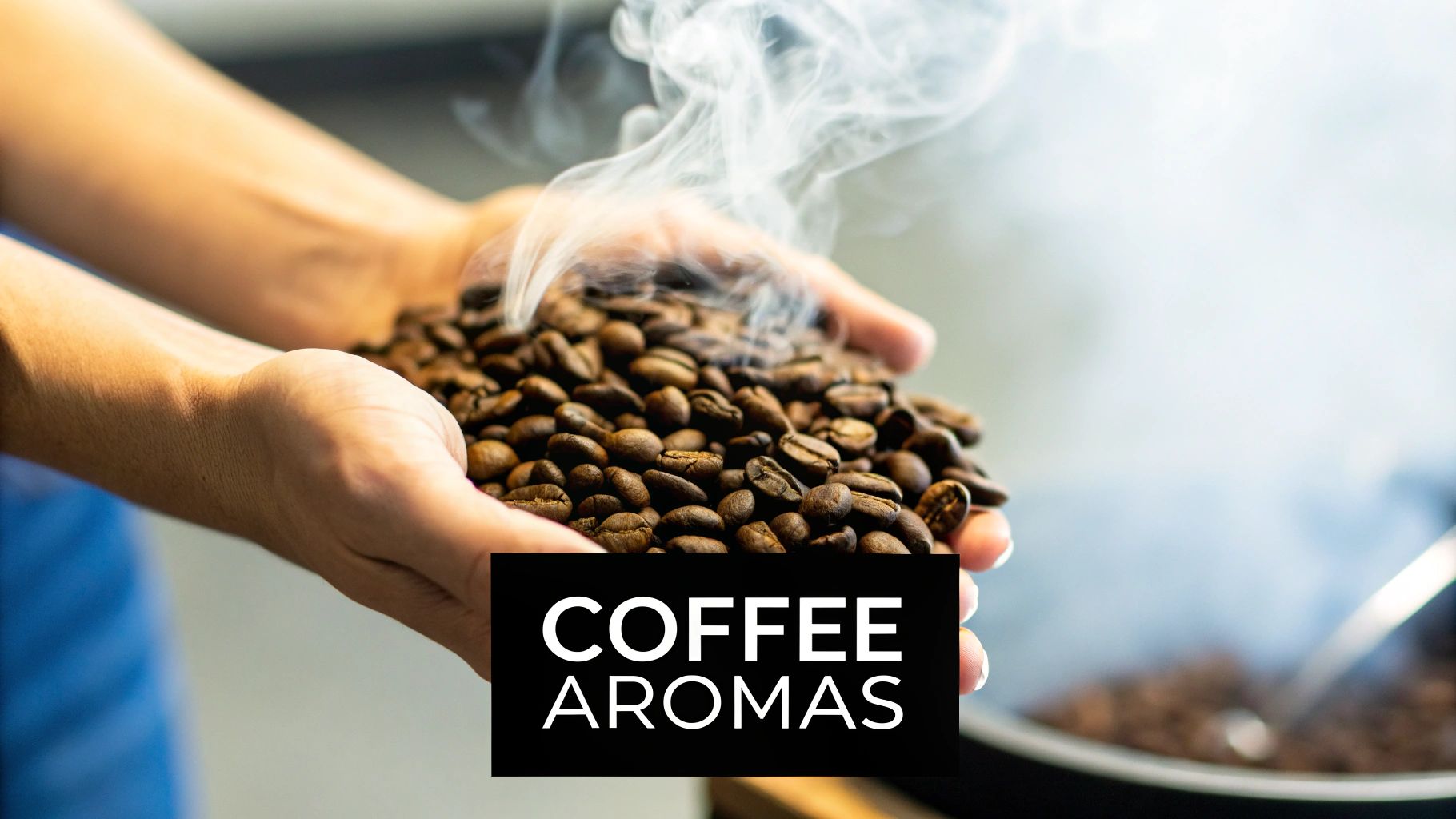
Let's be honest, the soul of any memorable coffee tasting is the beans themselves. This is where you get to play curator, choosing coffees that tell a fascinating story of place, process, and passion. Forget the supermarket shelves. By tapping into the UK's thriving independent roaster scene, you'll find exceptional quality and ethically sourced coffees that make all the difference.
To pull off a truly special tasting, you need to connect with roasters who live and breathe coffee. These are the artisans who build direct relationships with farmers, ensuring traceability and often paying a premium for the most outstanding crops. That direct link from farm to roastery is where the magic really begins.
Curating Your Coffee Flight
Think of your selection as a 'flight' of coffees, much like you'd get in a wine or whisky tasting. The goal is to pick beans that offer a compelling contrast, allowing everyone to explore the incredible diversity of flavour that coffee holds. This is how you build a narrative for your event.
A brilliant way to start is by focusing on three key variables:
- Origin: Choose coffees from different continents. For instance, you could pit a bright, floral Ethiopian coffee against a rich, chocolatey bean from Brazil. The difference in terroir—the soil, climate, and altitude—creates dramatically different flavour profiles that are amazing to compare side-by-side.
- Processing Method: How the coffee cherry is handled at the farm has a massive impact on the final taste. A 'natural' process (where the cherry is dried whole) often gives you jammy, fruity notes, while a 'washed' process (where the fruit is removed before drying) typically yields a cleaner, more acidic cup.
- Roast Profile: A lighter roast will preserve the delicate, origin-specific notes of the bean. Go for a darker roast, and you'll start to introduce flavours of caramel, chocolate, and smoke from the roasting process itself.
By choosing beans that differ in just one of these areas, you create a really clear point of comparison. Imagine tasting a naturally processed Ethiopian bean next to a washed one from the very same region; the contrast will be an incredible lesson in flavour for you and your guests.
How to Read a Coffee Bag Like a Pro
That information printed on a speciality coffee bag? It’s your guide to the bean's unique story. Learning to decode it is a crucial skill for anyone wanting to get more out of their coffee, and it’s your first clue to the flavours you’re about to unlock.
When you pick up a bag from a UK speciality roaster, here’s what to look for:
- Origin (Country & Region): This tells you the coffee's birthplace. A coffee from Yirgacheffe in Ethiopia will taste worlds apart from one from Huehuetenango in Guatemala.
- Producer/Farm: Many UK roasters name the specific farm or cooperative. This highlights their direct trade relationships and gives credit where it's due.
- Varietal: Just like grapes for wine (think Pinot Noir vs. Chardonnay), coffee has different varietals like Gesha, Bourbon, or Typica. Each has its own distinct flavour potential.
- Processing Method: As we mentioned, this is critical. Look for terms like 'Washed', 'Natural', or 'Honey' to get a sense of how the bean was prepared.
- Tasting Notes: These aren't added flavours! They are the roaster's interpretation of the aromas and tastes you can expect to find, like "candied orange, milk chocolate, and hazelnut."
Your journey into a deeper appreciation for coffee begins with curiosity. Don't just buy a bag of beans; buy the story behind it. Ask your local roaster why they chose that specific farm or what makes a particular varietal so special.
Ultimately, sourcing your beans is an act of exploration. Visit local roasteries, chat with the passionate people behind the counter, and try their recommendations. Building this connection not only guarantees fresher, higher-quality beans but also enriches your entire coffee tasting by connecting you to a vibrant, UK-wide community that celebrates every single cup.
Create Your Ideal Tasting Environment
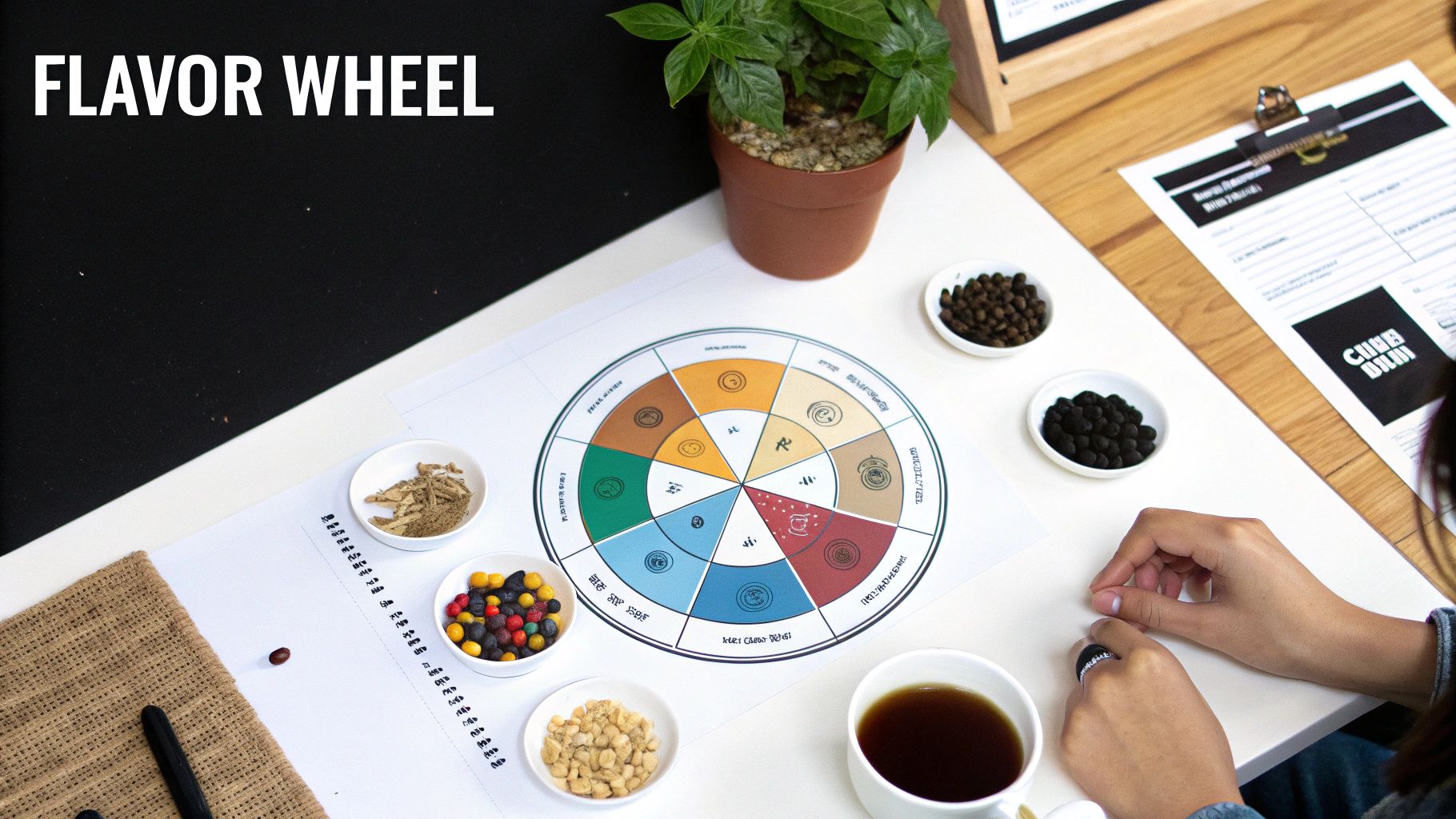
To really get to the heart of what makes a coffee special, you first need a space that lets your senses do their job. Think of your environment as a silent partner in the tasting—it can either amplify the delicate notes you’re hunting for or completely drown them out. The aim is to create an atmosphere that feels intentional but relaxed, sparking a bit of genuine curiosity in everyone.
This doesn't mean you need a sterile, lab-like setting. A welcoming spot in your home or a quiet corner of your local independent cafe can be absolutely perfect. The real key is to minimise any sensory competition, ensuring the coffee remains the undisputed star of the show.
Setting the Sensory Stage
Before a single bean gets ground, take a look around your chosen space. A good setup primes your palate and your mind for the coffee tasting experience to come. What else will your senses pick up besides the coffee?
Strong perfumes, scented candles, or lingering cooking smells are the enemy here; they’ll absolutely interfere with your ability to detect the coffee’s true aroma. It’s always best to find a neutral-smelling room. Good, natural light is a massive help, too, allowing you to properly see the colour and clarity of the brew—little visual clues that hint at its character.
Choosing Your Brewing Method and Tools
The gear you use will directly shape the tasting. While the professional gold standard is ‘cupping’—a simple process of steeping coffee grounds in a bowl—it’s by no means the only way to get brilliant results at home. Consistency is what really counts.
Whatever method you land on, make sure you use it for every single coffee in your lineup. This ensures a fair, side-by-side comparison. A cafetière (French press) is a fantastic and accessible choice, as it produces a full-bodied brew that keeps all the coffee's natural oils intact.
To get started, here's a quick look at the essential kit, comparing the professional standard with some easy-to-find home alternatives.
Essential Equipment for Your Coffee Tasting
This simple checklist covers what you’ll need, whether you’re aiming for a professional setup or using what you’ve got at home.
| Equipment | Professional Cupping Standard | Accessible Home Alternative |
|---|---|---|
| Grinder | A high-precision burr grinder for uniform particle size. | A quality electric or manual burr grinder. |
| Vessels | Identical ceramic or glass cupping bowls (200-260ml). | Identical mugs, small bowls, or heatproof glasses. |
| Spoons | Deep-bowled cupping spoons for slurping. | A set of deep soup spoons. |
| Kettle | A temperature-controlled gooseneck kettle for precision. | Any kettle, used with a thermometer for accuracy. |
| Scales | Digital scales accurate to 0.1 grams. | Standard digital kitchen scales. |
| Water | Filtered water meeting specific mineral content standards. | Good quality filtered tap water (e.g., from a filter jug). |
If you're going to invest in one piece of kit, make it a high-quality burr grinder. It’s the single most important tool for achieving a consistent grind size, which is absolutely critical for an even extraction and avoiding those muddy, unbalanced flavours.
Assembling Your Sensory Toolkit
Beyond the brewing hardware, a few simple tools can elevate your tasting from a casual drink-along to a genuinely insightful exploration. This sensory toolkit is all about helping you and your guests find the right words for what you’re tasting and smelling.
The most rewarding part of a coffee tasting is that 'aha!' moment when a guest identifies a specific flavour for the first time. A simple sensory toolkit is the key that unlocks that discovery.
Here are a few essential items to have on hand:
- Notepads & Pens: Get everyone to jot down their first impressions. What do they smell right away? What flavours come to mind? There are no wrong answers here.
- Coffee Flavour Wheel: This is an invaluable guide, especially for newcomers. It helps tasters move from a general term like "fruity" to something much more specific, like "strawberry" or "lime." You can find printable versions online.
- Spit Cups: Offer small cups for tasters to spit into if they wish. It’s standard practice in the industry to prevent caffeine overload and keep the palate fresh.
- Glass of Water: A simple glass of water for each person is perfect for cleansing the palate between tasting different coffees.
With your space prepped and your tools at the ready, you’ve laid the groundwork for an experience that encourages focus, conversation, and a deeper appreciation for the craft in every cup.
Master the Art of Sensory Tasting
Right, this is where the magic happens. We've done the prep, and now it's time to move from simply making coffee to truly perceiving it. This is how a simple drink becomes a full-on coffee tasting experience.
The professional tasting protocol, often called 'cupping', isn't nearly as intimidating as it sounds. We’re going to break it down into a simple, approachable method you can use anywhere, built around four key actions: Smell, Slurp, Locate, and Describe.
This structured approach is your ticket to unlocking the complex layers of flavour and aroma hidden in every bean. It trains your palate to go beyond a simple "that's nice" and gives you the language to pinpoint what makes each coffee unique. Get ready to change how you experience every single cup.
This visual guide breaks down the core stages of the process, from that first sniff to the final aftertaste.
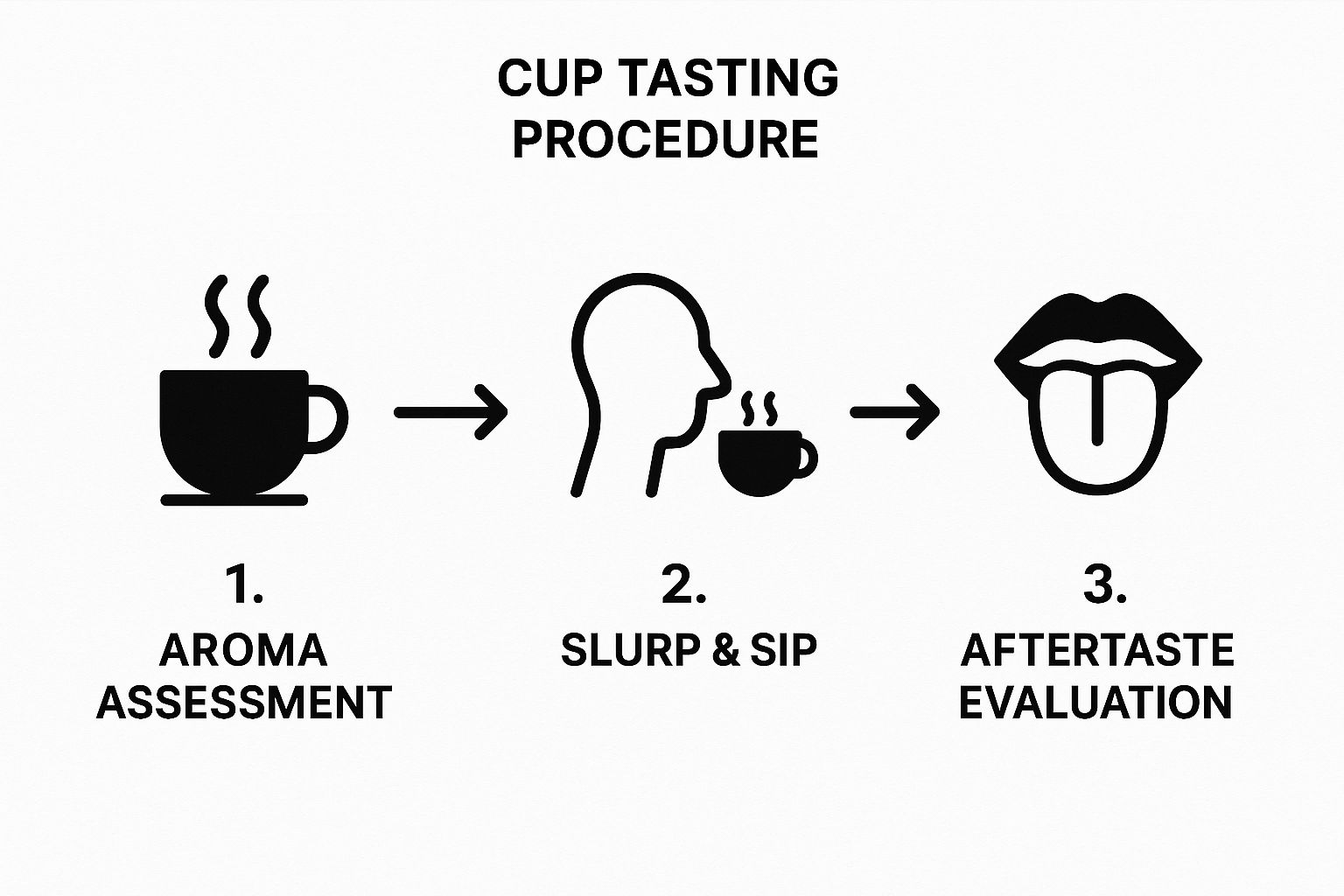
Following this simple flow ensures you assess each coffee consistently. It makes for fair comparisons and helps you zero in on specific details at each stage.
The Initial Encounter: Fragrance and Aroma
Your sensory journey starts long before the coffee ever touches your lips. Smell makes up a huge part of how we perceive flavour, and in coffee tasting, we look at it in two distinct phases.
First up is the fragrance—the scent of the dry, freshly ground coffee. This is your purest glimpse into the bean’s inherent character. Give the grounds a gentle shake in the cup and take a deep sniff. Are you getting floral notes, something nutty, or a bit of spice?
Next comes the aroma, which is the scent released when you add hot water. This is when the coffee truly comes alive, letting go of its most volatile and expressive compounds. As you 'break the crust' (the layer of grounds on the surface), get your nose right in there and inhale. This is often the most intense and revealing moment of the entire process.
The Art of the Slurp
This is going to feel weird at first, but trust me, the 'slurp' is non-negotiable. Instead of sipping politely, you need to aspirate the coffee with a sharp, loud slurp that sprays the liquid across your entire palate. It's not just for show; this has a critical purpose.
By spraying the coffee across your tongue and the roof of your mouth, you engage all your taste receptors at once. More importantly, it forces aromatic compounds up into your nasal passage from the back of your throat—a process known as retronasal olfaction. This is literally how you taste with your nose, unlocking a whole spectrum of nuanced flavours that a simple sip would completely miss.
Don't be shy. A loud, confident slurp is the sign of someone taking their tasting seriously. It's the single best way to aerate the coffee and get a complete picture of its flavour profile.
Locate and Describe What You Experience
With the coffee now coating your palate, it’s time to pay attention. The final two steps, Locate and Describe, happen almost simultaneously. First, try to locate the fundamental tastes.
- Sweetness: Can you find a sugary hint, like ripe fruit or caramel?
- Acidity: This isn't sourness. Think of it as a pleasant, bright sparkle, like you'd find in a crisp apple or a squeeze of citrus. It gives the coffee life.
- Bitterness: A little bitterness can add complexity, like dark chocolate, but it should never be harsh or overpowering.
- Body: How does the coffee feel? Is it light and tea-like, or is it heavy and creamy like full-fat milk?
Once you’ve got a handle on those core elements, you can start to describe them with more detail. This is where a flavour wheel becomes your best friend. Is that acidity like lemon, grapefruit, or green grapes? Is the sweetness more like honey, brown sugar, or strawberry jam?
This kind of detailed, sensory-driven experience is taking off across the UK, where over 98 million cups of coffee are consumed daily. This shift lines up with a growing consumer awareness of sustainability, as people increasingly want traceable, organic, and ethically sourced beans. You can explore more on these UK coffee consumption statistics to see how the trends are evolving.
Finally, think about the aftertaste, or 'finish'. What flavours are left lingering after you swallow or spit? A high-quality coffee will have a clean, pleasant, and lasting finish that makes you want to go back for another slurp.
By consistently using these four steps—Smell, Slurp, Locate, and Describe—you’ll build a sensory memory bank, empowering you to talk about and enjoy coffee with a whole new level of confidence.
Take Your Tasting to the Next Level with Pairings and Themes
You’ve got the beans sorted, the gear is ready, and you know what to look for in the cup. So, what’s next? This is where you add a touch of theatre. Turning a simple tasting into a genuinely memorable event is all about creating a story, and the best way to do that is with well-chosen food pairings and a clear theme.
It’s these simple touches that transform a good coffee tasting into an unforgettable one. You’re not just serving coffee anymore; you’re guiding your guests on a curated journey of flavour, right from your kitchen table.
The Art of Pairing Coffee and Food
Pairing coffee with food is a delicate dance. You're looking for something that either complements a flavour already in the coffee or provides a delightful contrast. The goal is to make both the coffee and the food taste even better. Luckily, with the UK’s incredible baking and confectionery heritage, you have plenty of brilliant local options to play with.
Start by thinking about the dominant profile of your coffee, then build from there.
- For bright, acidic coffees: A zesty Kenyan or a floral Ethiopian bean just sings when paired with citrus. A slice of lemon drizzle cake or even a simple shortbread biscuit with a dab of lemon curd will beautifully accentuate those bright, lively notes.
- For chocolatey, nutty coffees: Rich, comforting beans from places like Brazil or Colombia are a natural match for a classic digestive, a buttery flapjack, or a decadent chocolate brownie. The pairing just dials up the coffee’s inherent sweetness and body.
- For fruity, complex coffees: Naturally processed coffees with those jammy, berry-like notes are fantastic with fruit-forward treats. Think a raspberry Bakewell tart or a scone with strawberry jam. It’s a harmonious flavour explosion.
The secret to a perfect pairing is balance. The food should never overpower the coffee, and the coffee shouldn't dominate the food. They should lift each other up, creating a combined experience that's greater than the sum of its parts.
Weaving a Narrative with a Theme
A theme gives your tasting a purpose and a story. It guides which beans you choose and helps your guests understand the connections between each cup. This small step transforms the event from a random selection into a focused exploration, making the whole thing far more engaging.
This thematic approach is often what sets the UK's brilliant independent coffee shops apart. Valued at around £4.6 billion, the indie scene thrives on creating these unique, curated sessions. Unlike large chains, they excel at offering speciality brews that invite you to explore depth and complexity. You can learn more about the state of the UK's independent cafe industry and see how these passionate businesses are shaping our national palate.
Inspiring Themes for Your Next Tasting
You can build a theme around almost any aspect of coffee. The key is to pick a concept that genuinely sparks your own curiosity—your passion will be infectious.
Here are a few ideas to get you started:
- A Tour of a Continent: Focus on one major coffee-growing region. You could present a flight of three distinct South American coffees—perhaps a nutty Brazilian, a balanced Colombian, and a vibrant Peruvian. This lets you chat about how terroir and local farming practices shape the final flavour, even within a single continent.
- Exploring Processing Methods: This one is a fantastic educational theme and often creates a real 'aha!' moment for guests. Find beans from the same farm or region that have been processed differently—one washed, one natural, and maybe one honey-processed. It’s a crystal-clear demonstration of how dramatically processing impacts what you taste in the cup.
- The Roaster's Showcase: Why not celebrate local craftsmanship? Pick a single UK roaster you admire and select three of their flagship single-origin coffees. This theme is a wonderful way to support a local business and share that roaster’s specific style and philosophy with your friends.
By introducing pairings and a compelling theme, you’re adding layers of fun, education, and story. You’re no longer just a host; you become a storyteller, guiding your guests through an aromatic adventure that will stay with them long after the last cup is empty.
Your Coffee Tasting Questions Answered
Jumping into your first coffee tasting is exciting, but it’s completely normal to have a few questions. Getting the details right isn't just about the beans; it's about building your confidence as a host. This section is all about giving you clear, simple answers to the most common queries, so you can run your tasting smoothly and make sure everyone has a brilliant time.
Think of this as the final check before the big day. Nailing these small things will help everyone relax and really get lost in the amazing world of speciality coffee.
How Many Coffees Should I Include in a Tasting Session?
For your first few tastings, aim for three to four different coffees. That’s the sweet spot. It’s enough to showcase some real variety without overwhelming everyone’s palate.
A great starting point is to pick coffees from different corners of the world—maybe one from Africa, one from South America, and one from Asia. This makes it much easier for beginners to pick up on the distinct differences in aroma, body, and flavour. Once you get more comfortable, you could push it to five or six, but just be aware of palate fatigue. The goal is quality over quantity.
What Is the Best Brewing Method for a Coffee Tasting?
In the professional world, we use a method called 'cupping'. It’s super simple: coarse coffee grounds are steeped in hot water and then tasted with a spoon. This gives you the purest, most direct taste of the bean with nothing getting in the way.
But for a more relaxed tasting at home, you don't need to be so rigid. The most important thing is consistency.
- Keep it Consistent: Whatever method you choose, you must use it for every single coffee. A cafetière (French press) is a fantastic option because it doesn’t use a paper filter, so all the natural oils and body of the coffee make it into the cup.
- Pour-Over Works Too: If you have a larger pour-over brewer that can make multiple cups, that’s another great way to get a clean, clear brew.
- The Golden Rule: Use the exact same brew ratio, grind size, and water temperature for each coffee. This is non-negotiable, as it’s the only way to guarantee you’re giving each bean a fair comparison.
Do I Need a Coffee Flavour Wheel to Host a Tasting?
You don’t need one, but it’s an incredibly useful tool, especially if your guests are new to this. A coffee flavour wheel gives everyone a shared language to talk about what they’re tasting. It helps people move beyond simple words like ‘fruity’ and find more specific notes, like ‘blackberry’ or ‘grapefruit’.
A flavour wheel isn’t there to tell you what to taste. It’s there to show you what’s possible to taste. It nudges everyone to think beyond the obvious and turns what could be a guessing game into a really fun, educational experience.
You can easily find them online to print out and share. It’s a simple touch that can spark some amazing conversations and lead to those real 'aha!' moments of discovery.
Can I Do a Coffee Tasting with Decaf Coffee?
Absolutely! And you should. The days of decaf being a flavourless, chemical-tasting afterthought are long gone. Modern methods like the Swiss Water or Sugarcane EA processes are amazing at preserving the coffee's delicate, original flavours.
Including a top-notch decaf from a quality UK speciality roaster is a brilliant way to surprise your guests and bust some old myths. It’s also a thoughtful, inclusive choice for anyone who’s sensitive to caffeine or for tastings held later in the day. Just make sure you buy from a roaster who is transparent about the decaffeination method—it’s a true sign of quality.
Ready to source exceptional beans for your next tasting? At Ue Coffee Roasters, we offer a curated selection of single origins, unique blends, and high-quality decaf coffees perfect for any tasting flight. Explore our coffee collection.
